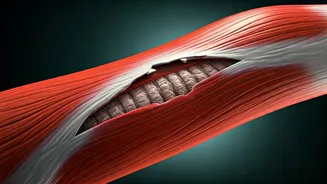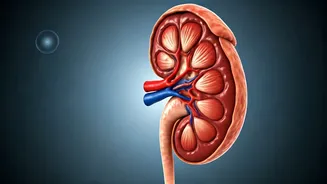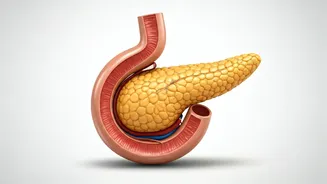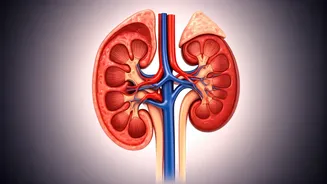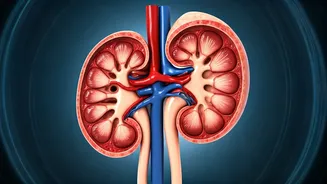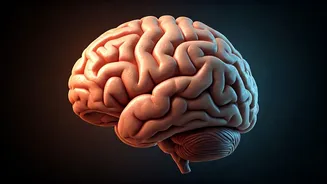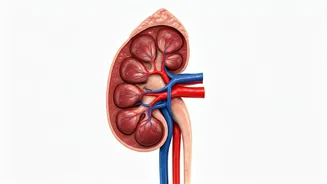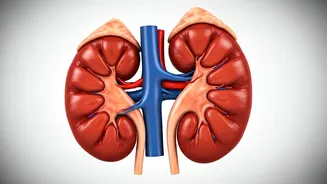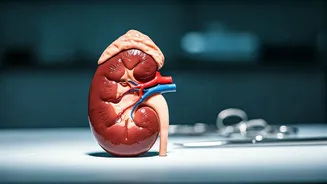Muscle Cell Breakdown
Rhabdomyolysis is characterized by the rapid breakdown of muscle tissue, resulting in the release of intracellular contents into the bloodstream. These
contents, including myoglobin, can damage the kidneys and cause various health complications. Intense physical activity, such as strenuous exercise or trauma, can trigger this process. Other factors, like certain medications, infections, and genetic predispositions, may also play a role. It is important to know that the severity of rhabdomyolysis varies. While some cases are mild and resolve quickly, others can be severe and life-threatening. The prompt diagnosis and treatment are crucial to prevent or minimize kidney damage and other complications. The symptoms can range from muscle pain and weakness to dark urine and systemic symptoms like fever and nausea.
Athlete's Increased Risk
Athletes are at higher risk of developing rhabdomyolysis due to the intense physical demands placed on their muscles. The repetitive stress and high-intensity workouts can damage muscle fibers, leading to the breakdown of muscle tissue. Moreover, athletes often push their bodies to the limit, potentially exceeding their physiological capacity. This can lead to muscle damage that is too severe for the body to repair quickly. Dehydration and electrolyte imbalances, common in athletes, can also increase the risk. Factors such as overtraining, inadequate recovery, and heat stress further exacerbate the risk. Recognizing early symptoms and promptly seeking medical attention is crucial for athletes to prevent this condition from becoming severe.
Causes and Triggers
Several factors contribute to the development of rhabdomyolysis. Strenuous exercise, particularly when unaccustomed or excessive, is a primary trigger. Trauma, such as crush injuries or falls, can directly damage muscle tissue. Infections, especially viral or bacterial, can sometimes lead to muscle breakdown. Certain medications, including statins and some antibiotics, have been associated with rhabdomyolysis. Genetic disorders that affect muscle metabolism can also increase susceptibility. Furthermore, substance abuse, including alcohol and drugs, can play a role. Understanding these causes helps in identifying risk factors and implementing preventive measures. It is important to note that rhabdomyolysis can have multiple causes. Thus, it often requires a thorough medical evaluation to identify the specific triggers.
Recognizing Symptoms
Symptoms of rhabdomyolysis can vary in severity. Muscle pain, particularly in the shoulders, thighs, or lower back, is a common early sign. Muscle weakness can range from mild to severe, affecting the ability to perform daily tasks or engage in physical activity. Dark or tea-colored urine, due to the presence of myoglobin, is another key indicator. Other symptoms may include fatigue, nausea, vomiting, fever, and abdominal pain. Some individuals might experience symptoms like malaise, or a general feeling of being unwell. It's important to seek medical attention immediately if these symptoms are noticed, especially after intense physical activity or trauma. Timely diagnosis and intervention are vital to prevent kidney damage and other life-threatening complications.
Diagnosis and Treatment
Diagnosing rhabdomyolysis usually involves a combination of medical history, physical examination, and diagnostic tests. A healthcare provider will ask about the patient's symptoms, activity level, and any potential risk factors. A physical examination helps assess muscle tenderness and weakness. Blood tests are crucial to measure levels of creatine kinase (CK), an enzyme released from damaged muscle cells. Elevated CK levels are a key indicator of rhabdomyolysis. Urine tests can detect myoglobin. Other tests may assess kidney function. Treatment focuses on preventing kidney damage and managing complications. Intravenous fluids are administered to flush out the kidneys and prevent further damage. Electrolyte imbalances are addressed. In severe cases, dialysis may be required to support kidney function. Prompt intervention can significantly improve outcomes and reduce the risk of long-term complications. The recovery period varies. However, it often involves rest and rehabilitation to regain muscle strength.
